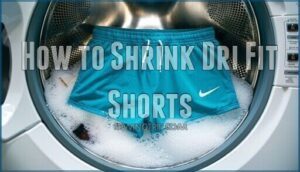This site is supported by our readers. We may earn a commission, at no cost to you, if you purchase through links.
 Dri-Fit fabrics resist shrinking by design, but you can make them smaller with targeted heat exposure.
Dri-Fit fabrics resist shrinking by design, but you can make them smaller with targeted heat exposure.
The synthetic polyester blend won’t budge with normal washing, but hot water cycles combined with high-heat drying can coax out 5-10% shrinkage.
You’ll need temperatures around 140°F+ and extended dryer sessions to see results. The trick isn’t just cranking up the heat—timing and technique matter.
Some swear by the boiling water method, while others prefer gradual shrinking through multiple wash cycles. Your success depends on the specific fabric blend and how much shrinkage you’re after.
Table Of Contents
- Key Takeaways
- Will Dri Fit Shrink?
- Does Dri Fit Shrink in The Wash?
- Does Nike Dri Fit Shrink in The Dryer?
- Can Dri Fit Go in The Dryer?
- Is There a Way to Shrink Dri Fit Shirts?
- Best Way to Shrink a Dri Fit Shirt
- How to Shrink Dri Fit Shorts
- How to Shrink a Shirt in The Dryer
- How to Shrink a Shirt in The Washer
- Frequently Asked Questions (FAQs)
- Conclusion
Key Takeaways
- You can shrink Dri-Fit, but results depend on fabric composition – Cotton blends shrink 2-5% while pure polyester only shrinks about 1%, so check your garment’s label first
- Use hot water (140°F+) and high-heat drying for best results – Combine hot wash cycles with extended dryer sessions, checking every 5-10 minutes to prevent over-shrinking
- Gradual shrinking works better than aggressive single attempts – Multiple controlled heat cycles preserve fabric integrity and moisture-wicking properties while achieving your desired fit
- Monitor carefully to avoid permanent damage – Excessive heat can melt polyester fibers and destroy the technical features that make Dri-Fit appealing, so start conservatively
Will Dri Fit Shrink?
Yes, Dri Fit shrinks, but the amount depends entirely on your fabric composition.
Cotton-blend Dri Fit materials will shrink more than pure polyester versions – we’re talking 2-5% shrinkage versus just 1% respectively.
You’ll notice the biggest changes during your first wash and dry cycle, especially if you crank up that heat.
The science behind fabric shrinkage reveals why material blends matter so much.
Cotton fibers naturally contract when exposed to heat and agitation, while polyester resists these changes.
That’s why checking your garment’s label becomes vital for predicting shrinkage risks before you toss it in the machine.
Your drying methods make the real difference here.
High heat settings will maximize shrinkage in cotton blends, but they can damage pure polyester by causing fiber deformation.
Understanding these fabric types gives you control over the final fit – whether you want to shrink dri fit clothes intentionally or prevent unwanted changes through proper dri fit care techniques.
To prevent unwanted shrinking, it’s best to think about gentle washing methods.
Does Dri Fit Shrink in The Wash?
Hot water acts as the primary catalyst when considering does dri fit shrink during washing cycles. Your washing machine’s temperature settings directly influence shrinkage factors, with temperatures above 100°F triggering fiber contraction in dri fit fabric compositions.
Polyester shrinkage remains minimal compared to cotton blends, but heat still affects synthetic materials. Detergent choice plays a vital role in fabric preservation. Harsh chemicals can weaken fibers and compromise moisture-wicking properties, while gentle formulas maintain fabric integrity.
Cold water washing prevents unwanted shrinkage and preserves the technical features that make Dri-Fit appealing. The fabric composition determines your garment’s vulnerability to size changes. Pure polyester maintains stability, while cotton-polyester blends show increased susceptibility to shrinkage.
Understanding how to shrink dri fit starts with recognizing these material differences. Dri-FIT’s resistance is due to its polyester composition. Shrinkage prevention becomes your best defense against unwanted size changes.
Monitoring wash cycles, selecting appropriate temperatures, and choosing compatible detergents help maintain your garment’s original fit and performance characteristics throughout its lifespan.
Does Nike Dri Fit Shrink in The Dryer?
The dryer transforms into your Nike Dri-Fit’s biggest test when heat meets synthetic fibers. Dryer Heat Effects create the primary catalyst for shrinkage, with Polyester Shrinkage Rate typically reaching 1% compared to Cotton Blend Behavior showing 2-5% reduction.
Your Nike drifit responds differently based on material composition – pure polyester resists shrinkage while blended fabrics contract more dramatically. Understanding Dri-FIT fabric technology is key to predicting garment behavior.
Monitoring Dryer Time becomes essential since synthetic fibers tighten progressively under sustained heat exposure. Check your garment every 5-10 minutes to control the process and prevent over-shrinking. Avoiding Damage requires understanding that excessive heat degrades moisture-wicking properties permanently.
Does dri fit shrink in the dryer? Absolutely, but the extent depends on your specific fabric blend. How to shrink dri fit effectively involves using high heat settings while maintaining vigilant oversight. The dri fit dryer relationship demands respect – too much heat destroys performance features, while controlled exposure achieves desired size reduction.
Shrinkage prevention starts with understanding your garment’s material composition before applying heat.
Can Dri Fit Go in The Dryer?
Dri-Fit garments can technically go in the dryer, but approach with caution to protect your investment. The dri fit dryer compatibility depends on understanding dryer heat effects on synthetic materials.
Most Dri-Fit fabrics contain polyester, which has a relatively low polyester melting point around 250°F – well below many dryer’s high heat settings. Safe drying methods involve using low or no-heat settings exclusively.
Heat exposure above 140°F risks damaging moisture-wicking properties and causing unwanted polyester shrinkage. While you can shrink dri fit clothes intentionally, preventing accidental shrinkage requires careful temperature control during dri fit washing and drying cycles.
One should note that cotton blends can shrink more readily than polyester. Alternative drying options like air drying remain superior for preserving fabric integrity.
Shrinkage prevention tips include removing garments while slightly damp and avoiding high-heat settings entirely. Your Dri-Fit’s performance depends on respecting these thermal boundaries.
Is There a Way to Shrink Dri Fit Shirts?
Understanding your Dri Fit’s fabric composition reveals successful shrinking strategies. Material matters substantially when attempting size reduction—cotton blends respond better to heat than pure polyester versions.
Here are four proven shrinking approaches:
- Hot wash + high heat drying – Most effective for cotton-blend Dri Fit shirts
- Boiling water soak – Gentle 5-minute submersion before regular laundry cycles
- Steam iron application – Targeted shrinking for specific areas needing adjustment
- Professional alteration – Safest option for expensive polyester garments
Shrinkage risks vary by fabric type. Cotton-blend versions can shrink 2-5%, while polyester manages only 1%. Understanding that synthetic fibers resist shrinking is key to choosing the right method. Heat exposure must be monitored carefully to prevent damage to moisture-wicking properties.
Fit assessment after each attempt helps determine if additional shrinking is needed. Alternative methods like professional tailoring offer precision without risking fabric integrity. If over-shrinking occurs, the unshrinking process involves hair conditioner soaks and gentle stretching, though results aren’t guaranteed.
Best Way to Shrink a Dri Fit Shirt
Achieving perfect shrinkage requires controlled heat exposure to activate synthetic fibers in your Dri Fit garment.
Boil water in a large pot, then submerge the shirt for five minutes.
This hot water treatment initiates material shrinkage rates of 2-5% for cotton blends versus 1% for pure polyester.
Remove carefully and transfer immediately to your dryer on high heat for 45 minutes.
Hang drying is preferable to tumble drying, according to experts.
Monitor closely, preventing damage through regular checks every fifteen minutes.
Alternative shrinking methods include steam treatment for precise control.
Always assess fit changes between cycles to achieve your desired result.
How to Shrink Dri Fit Shorts
Shrinking shorts requires a different approach than shirts since you’ll want to maintain the waistband’s fit while adjusting the overall size. Start by checking your shorts’ material composition – polyester blends respond differently than cotton-heavy fabrics.
Here’s your game plan for controlled shrinkage:
- Heat Settings: Use hot water (140°F) followed by high dryer heat
- Material Matters: Polyester resists shrinking more than cotton blends
- Shrinkage Risks: Synthetic fibers can melt or lose elasticity under extreme heat
- Fit Assessment: Check every 5-10 minutes during drying to prevent over-shrinking
- Unshrinking Methods: Hair conditioner soaks can reverse minor shrinkage if needed
The key is patience and frequent monitoring. Dri Fit shorts typically shrink 1-3% with this method, but results vary based on the polyester-to-cotton ratio. Understanding the material blend is essential for achieving the desired results. If your first attempt doesn’t achieve the desired fit, you can repeat the process, though multiple heat cycles may compromise the moisture-wicking properties that make these shorts special.
How to Shrink a Shirt in The Dryer
Two key factors determine your success when shrinking shirts in the dryer: fabric composition and heat management. Cotton-based DriFit responds differently than synthetic blends, so you’ll need to adjust your approach accordingly.
Here’s your step-by-step process:
- Check Fabric Types – Pure cotton shrinks readily, while polyester-dominant blends resist shrinkage and may require multiple cycles
- Set Dryer Settings – Use high heat for cotton, medium for blends to prevent fiber damage while maximizing shrinkage potential
- Monitor Drying Techniques – Check every 10-15 minutes to control shrinkage levels and prevent over-processing
- Apply Heat Management – Complete full cycles for maximum effect, as partial drying won’t activate the fiber contraction process
The tumble action combined with sustained heat creates the perfect storm for shrinkage. Cotton fibers tighten naturally, while synthetic materials need extended exposure. Remember, you can’t undo excessive shrinking, so start conservatively. Multiple controlled cycles beat one aggressive attempt that ruins your shirt.
Understanding proper care methods is essential for achieving the perfect fit without damaging the fabric.
How to Shrink a Shirt in The Washer
Hot water transforms your washer into a powerful shrinking machine for cotton-based dri fit shirts. The chemical process activates natural fibers, causing them to contract when exposed to high temperatures and agitation.
Follow these washer settings for maximum fabric shrinkage:
- Set temperature to hottest setting – High heat activates cotton fibers for maximum shrinkage results
- Choose longest wash cycle available – Extended agitation time helps achieve even shrinkage throughout the garment
- Add towels to create friction – Extra items increase mechanical action for enhanced shrinking effect
Check your care labels before starting – 100% cotton responds best to this shrink method, while polyester blends resist change. Cotton-polyester combinations show limited shrinkage due to synthetic content. Use high spin cycles combined with hot washing for quick results.
Understanding silk fabric properties is vital for alternative shrinking methods.
Monitor your dri fit shirt between cycles to avoid over-shrinking. Multiple gentle treatments preserve fabric integrity better than one aggressive cycle. The gradual approach prevents damage while achieving your desired fit through controlled drying techniques.
Frequently Asked Questions (FAQs)
Can You shrink a dri fit shirt?
Ironically, these "performance" fabrics often perform exactly how you don’t want them to when sizing down.
Yes, you can shrink Dri-Fit shirts using hot water washes and high-heat drying, though success depends on material composition and risks damaging the fabric’s moisture-wicking properties.
Does Dri FIT shrink?
Yes, Dri-Fit materials can shrink, but it depends on their composition.
Cotton blends shrink more than pure polyester versions.
You’ll see 2-5% shrinkage with cotton content versus just 1% with polyester-only fabrics.
Do Nike dri-fit shirts shrink?
Nike Dri-Fit shirts can shrink, especially cotton blends. You’ll see 2-5% shrinkage with cotton versions versus just 1% with polyester. Heat from your dryer tightens fibers more than washing alone.
How do you shrink a dri fit?
Like turning up the heat on a stubborn situation, you’ll need strategic temperature control.
Wash your dri-fit in hot water, then dry on high heat while checking every few minutes to prevent over-shrinking and fabric damage.
Why is my Nike Dri FIT shrinking?
Your Nike Dri-FIT’s shrinking because you’re exposing it to heat – hot water washes and high dryer temperatures cause the synthetic fibers to contract and tighten, especially in cotton blends.
Can you shrink Dri-FIT?
Dri-FIT materials can shrink, but you’ll need different approaches depending on the fabric blend. Cotton blends respond well to hot water washing and high-heat drying.
Can you put Dri-FIT in the dryer?
Imagine this: your favorite workout shirt just came out of a scorching hot dryer cycle.
You can put Dri-FIT in the dryer, but use low heat settings to prevent damage and shrinkage, especially with polyester blends.
How to make Dri-FIT looser?
You can’t really "unshrink" Dri-FIT effectively once it’s tightened. Try soaking it in lukewarm water with hair conditioner, then gently stretch while damp and air dry flat.
Should I size up with Dri-FIT?
Yes, you should size up when buying Dri-FIT clothing.
These garments can shrink 1-5% after washing, especially cotton blends.
Sizing up guarantees a comfortable fit even after inevitable shrinkage from heat exposure.
Can you unshrink a Dri Fit shirt?
Like trying to un-ring a bell, you can attempt to unshrink your Dri-Fit shirt by soaking it in lukewarm water with hair conditioner, then gently stretching and air-drying it flat.
Conclusion
Success transforms oversized Dri-Fit into your perfect companion.
While these synthetic blends resist traditional shrinking methods, targeted heat exposure delivers measurable results.
The key lies in understanding that does dri fit shrink how to depends on temperature control and patience.
High-heat washing at 140°F+ combined with extended dryer cycles produces 5-10% reduction.
Remember, gradual shrinkage through multiple treatments often yields better results than aggressive single attempts.
- https://www.fabricfits.com/how-to-shrink-a-dri-fit-shirt/
- https://luckywholesale.net/blogs/news/does-dri-fit-shrink-how-to-shrink-dri-fit-shirts-6-tips
- https://fabrictopics.com/do-nike-dri-fit-shirts-shrink/
- https://outfitlovers.com/will-dri-fit-shirts-shrink/
- https://sewingiscool.com/does-dri-fit-shrink-how-to/












